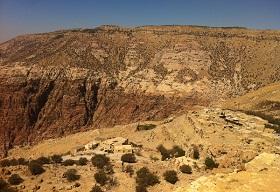Using AI to control energy for indoor agriculture
30 September 2024
Published online 5 February 2013

A lifeline to feed water from the Red Sea to the Dead Sea that could save the famous salt lake from shrinking further has the backing of the World Bank, despite myriad environmental concerns.
The Dead Sea is falling at an alarming rate of 0.8 to 1.2 metres every year, largely due to water diversions from its main tributary, the Jordan River. Surveys suggest that a proposed 180-kilometre connection to convey water from the Red Sea to blend with the hypersaline waters of the Dead Sea may breathe life into it.
The project, which would be a partnership between Israel, Jordan and the Palestinian Authority, all riparians of the Dead Sea, has raised the ire of environmentalists, who are worried it might destroy fragile natural areas such as Wadi Arabah, affect life in the Red Sea and change the Dead Sea chemical composition.
The World Bank's draft report, a culmination of studies since 2005, considered three scenarios: no action taken; a simple canal connecting the two seas to stabilize the Dead Sea; and a canal that is accompanied by a desalination plant powered by the generation of hydroelectricity made possible by the 400m difference in elevation.
The Bank's endorsement of the feasibility came as no surprise to some analysts. "We expected the World Bank to endorse the project because the political decision has already been taken to carry through with it," says Batir Wardam, an environmental analyst in Jordan.
According to the report, the sea level will continue to drop if the heavy potash industries around the Dead Sea in Israel and Jordan continue production at the same rate. Even if they stop completely, the level will still decline, but at a slower rate, finally stabilizing at 550 metres below sea level in about 140 years. The impact on the tourism and chemical industries reliant on the Dead Sea will be significant.
Jordan is one of the ten most water-scarce countries in the world. Most of the country's major surface water resources are shared by neighbouring Israel and Syria who use up most of the water before it reaches Jordan. Groundwater resources are overexploited, making them unsustainable in the long run.
This makes water desalination one of the options to secure the water future of Jordan. "The main goal for us out of this project is to desalinate the Red Sea waters to produce clean drinking water for Jordanians. It is a matter of water security for Jordan," says Basem Telfah, secretary general of Jordan's Ministry of Water and Irrigation.
This project is very important for Jordan, but neither we nor the Palestinian Authority have enough money for it.
The study considered three possible methods of connecting the two seas: a tunnel; a tunnel and canal combination; and a pipeline conveyance. The latter will possibly have the lowest initial capital investment and be the most flexible in terms of its route it, thus preserving the many natural protectorates in the region.
However, it will demand the highest energy consumption due to the large pumping stations, estimated at about 1,920 GWh/year. It also has the largest carbon footprint and the highest running costs.
The three scenarios have their share of threatened impacts. Studies of the Red Sea show that environmental impact on habitats and water circulation will be minimal. While there isn't enough data yet on how the project would affect the coral reefs there, the study suggests that placing the water intake more than 90 metres below sea surface will minimise the impact.
There is some worry that water from the canal or pipe carrying the water may contaminate the groundwater aquifers it passes through, but the report suggests that "numerous measures and construction arrangements" in the pipeline design can minimize the risk of leakage and their impacts.
In the Dead Sea, the mixing of the waters can change the chemical composition of the water causing its surface to take on a white colour due to precipitation of gypsum.
Environmentalists are worried the change in the sea's chemical composition will alter the salinity and affect the bacteria living in the water. Dense microbial blooms of Dunaliella, a salt-tolerant unicellular green alga living in the Dead Sea, have been observed after heavy rain diluted the surface of the sea. Dilution by less saline water from the Red Sea might increase these blooms.
"You cannot really compare issues of bacteria with the amount of drinking water this project will secure for Jordan," says Wardam. "I think all the environmental impacts can eventually be dealt with."

© Mohammed Yahia
"We are really disappointed that the World Bank has thrown out all the environmental and economic concerns we had and came up with this study," says Munqeth Mehyar, director of the Jordanian Office for Friends of the Earth Middle East (FoEME).
According to the study, the project will require US$11 billion in capital. "This project is very important for Jordan, but neither we nor the Palestinian Authority have enough money for it," says Telfah.
"The study states the capital can be raised through US$5 billion grant aids and donations and around $2.5 billion loans for each partner," adds Mehyar. "The huge price tag of the project could bankrupt Jordan. We cannot afford this."
However, according to the World Bank, the economic benefits of the project could surpass the costs by around US$1 billion.
Mehyar says that FoEME proposed an alternative approach in 2007 to save the Dead Sea through considering restoration of the Jordan River, its main source. While historically, the river fed the Dead Sea with 1.3 billion cubic metres of fresh water per year, this has trickled down to less than 100 million cubic metres, mainly comprising sewage. Israel, Syria and Jordan all draw on the Jordan River for drinking and agriculture and chemical industries.
doi:10.1038/nmiddleeast.2013.19
Stay connected: